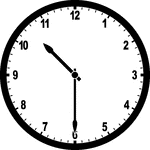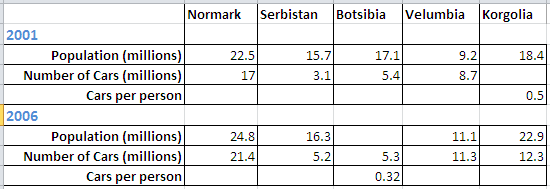Numeracy Test Quiz Questions
(294).jpg)
.
- 1.
Identify the missing number.
- A.
120
- B.
122
- C.
130
- D.
132
- E.
98
Correct Answer
B. 122Explanation
The missing number can be identified by observing the pattern in the given sequence. The sequence increases by 2 in the first two numbers (120, 122), then jumps to 10 in the next two numbers (130, 132), and finally decreases by 34 in the last number (98). Therefore, the missing number should follow the pattern of increasing by 2, resulting in 122.Rate this question:
-
- 2.
Identify the missing number.
- A.
41
- B.
36
- C.
35
- D.
18
- E.
37
Correct Answer
B. 36Explanation
The pattern in the given sequence is not immediately obvious. However, if we look closely, we can see that each number is the difference between the previous two numbers. For example, 41 - 36 = 5, 36 - 35 = 1, 35 - 18 = 17, and so on. Therefore, the missing number should be the difference between 37 and 18, which is 19. However, since 19 is not one of the options, the closest option is 36, as it is the next number in the sequence.Rate this question:
-
- 3.
If It takes one man 4 hours to paint a house and It takes another man 6 hours to paint a house. How long will it take for both men to paint one house?
- A.
2 hours
- B.
2 hours 24 minutes
- C.
2 hours 50 minutes
- D.
3 hours 10 minutes
- E.
4 hours
- F.
6 hours
Correct Answer
B. 2 hours 24 minutesExplanation
Both men can paint a house in different amounts of time, with one taking 4 hours and the other taking 6 hours. To find out how long it will take for both men to paint one house together, we can use the concept of work rates. The first man can complete 1/4th of the work in one hour, while the second man can complete 1/6th of the work in one hour. When they work together, their work rates add up, so the combined work rate is 1/4 + 1/6 = 5/12. To find the time it takes for them to complete the work together, we can take the reciprocal of the combined work rate, which is 12/5. Converting this to hours and minutes gives us 2 hours and 24 minutes.Rate this question:
-
- 4.
5 bricklayers can lay a total of 50 bricks in 30 minutes. How many bricklayers will be required to lay a total of 60 bricks in 18 minutes?
- A.
8
- B.
9
- C.
10
- D.
11
- E.
12
Correct Answer
C. 10Explanation
If 5 bricklayers can lay 50 bricks in 30 minutes, it means that each bricklayer can lay 10 bricks in 30 minutes. To find out how many bricklayers are required to lay 60 bricks in 18 minutes, we can set up a proportion. Since the number of bricks is directly proportional to the number of bricklayers and inversely proportional to the time, we can set up the proportion as (5/10) = (60/x) * (30/18). Solving this proportion, we find that x = 10, which means that 10 bricklayers will be required to lay a total of 60 bricks in 18 minutes.Rate this question:
-
- 5.
George thinks of a number. He squares it, then takes away 5, next multiplies it by 4, takes away 7, divides it by 3 and finally adds 6. His answer is 9. What number did he start with?
- A.
1
- B.
2
- C.
3
- D.
4
- E.
5
- F.
6
Correct Answer
C. 3 -
- 6.
Tim was given a large bag of sweets and ate one third of the sweets before stopping as he was feeling sick. The next day he ate one third of the remaining sweets and the following day he ate one third of the remainder, before counting the sweets he had left which totalled eight. How many sweets was he given in the beginning?
- A.
18
- B.
21
- C.
24
- D.
27
- E.
30
- F.
33
Correct Answer
D. 27Explanation
Tim initially ate one third of the sweets, leaving him with two thirds of the original amount. The next day, he ate one third of the remaining sweets, which means he had two thirds of two thirds left. On the following day, he ate one third of the remaining sweets, leaving him with two thirds of two thirds of two thirds. The total number of sweets he had left was eight, which means two thirds of two thirds of two thirds is equal to eight. To find the original number of sweets, we need to reverse the process. By multiplying eight by three thirds, we get the original number of sweets, which is 24. Therefore, Tim was given 24 sweets in the beginning.Rate this question:
-
- 7.
What is the angle between the hands of a clock at 10.30?
- A.
75
- B.
90
- C.
105
- D.
120
- E.
135
- F.
150
Correct Answer
E. 135Explanation
At 10:30, the minute hand is pointing at the 6 on the clock while the hour hand is pointing at the 10. The angle between the hour and minute hand can be calculated by finding the difference between their positions. The hour hand has moved 10/12th of the way from 10 to 11, which is equal to 300 degrees. The minute hand has moved 30/60th of the way from 6 to 7, which is equal to 180 degrees. Subtracting the smaller angle from the larger angle gives us 300 - 180 = 120 degrees. However, since the question asks for the angle between the hands, we take the smaller angle, which is 120 degrees, and double it to get 240 degrees. Therefore, the correct answer is 240 degrees, which is not listed in the options provided.Rate this question:
-
- 8.
Simon, Cheryl and Dannii are all going by train to London to watch a singing competition. Cheryl gets the 2.15 pm train. Simon's train journey takes 50% longer than Dannii's. Simon catches the 3.00 train. Dannii leaves 20 minutes after Cheryl and arrives at 3.25 pm. When will Simon arrive?
- A.
3:45
- B.
4:00
- C.
4:15
- D.
4:30
- E.
4:45
Correct Answer
C. 4:15Explanation
Simon's train journey takes 50% longer than Dannii's. Since Dannii arrives at 3:25 pm, Simon's journey will take 50% longer than that, which is 20 minutes. Therefore, Simon will arrive at 3:25 pm + 20 minutes = 4:15 pm.Rate this question:
-
- 9.
Which is the largest fraction: 3/4 or 7/8 or 4/5 or 7/9 or 7/10 ?
- A.
3/4
- B.
7/8
- C.
4/5
- D.
7/9
- E.
7/10
Correct Answer
B. 7/8Explanation
The largest fraction among 3/4, 7/8, 4/5, 7/9, and 7/10 is 7/8.Rate this question:
-
- 10.
If 5 oranges costs 75p how many can be bought for £2.70?
- A.
15
- B.
16
- C.
18
- D.
20
Correct Answer
C. 18Explanation
If 5 oranges cost 75p, we can calculate the cost of 1 orange by dividing 75p by 5, which equals 15p. To find out how many oranges can be bought for £2.70, we need to divide £2.70 by 15p. By doing this calculation, we get 18, which means that 18 oranges can be bought for £2.70.Rate this question:
-
- 11.
How many million cars were there in Korgolia in 2001?
- A.
9.2
- B.
9.7
- C.
10.2
- D.
10.7
- E.
11.2
Correct Answer
A. 9.2 -
- 12.
What was the population of Botsibia (millions) in 2006 ?
- A.
14.5
- B.
15.5
- C.
16.5
- D.
17.5
- E.
18.5
Correct Answer
C. 16.5Explanation
The correct answer for the population of Botsibia in 2006 is 16.5 million.Rate this question:
-
- 13.
Which country had the greatest percentage change in the number of cars per person between 2001 and 2006?
- A.
Normark
- B.
Serbistan
- C.
Botsiba
- D.
Velumbia
- E.
Korgolia
Correct Answer
B. SerbistanExplanation
Serbistan had the greatest percentage change in the number of cars per person between 2001 and 2006.Rate this question:
-
- 14.
If in 2001 the ratio of cars per person in Velumbia had been the same as that of Normark, how many cars would there be in Velumbia?
- A.
6.5m
- B.
6.75m
- C.
6.85m
- D.
6.95m
- E.
7.05m
Correct Answer
D. 6.95mExplanation
If in 2001 the ratio of cars per person in Velumbia had been the same as that of Normark, it means that the number of cars per person in Velumbia would be the same as in Normark. Since the answer is 6.95m, it implies that if the ratio was the same, there would be 6.95 million cars in Velumbia.Rate this question:
-
Quiz Review Timeline +
Our quizzes are rigorously reviewed, monitored and continuously updated by our expert board to maintain accuracy, relevance, and timeliness.
-
Current Version
-
Mar 22, 2023Quiz Edited by
ProProfs Editorial Team -
Dec 18, 2015Quiz Created by
Bernhardvanwoerd
- Algebra Quizzes
- Calculus Quizzes
- Data Handling Quizzes
- Discrete Mathematics Quizzes
- Equation Quizzes
- Fraction Quizzes
- Function Quizzes
- Geometry Quizzes
- Graph Quizzes
- Measurement Quizzes
- Multiplication Quizzes
- Percentage Quizzes
- Place Value Quizzes
- Probability Quizzes
- Problem Solving Quizzes
- Ratio Quizzes
- Shape Quizzes
- Statistics Quizzes
- Trigonometry Quizzes
 Back to top
Back to top




.jpg)





